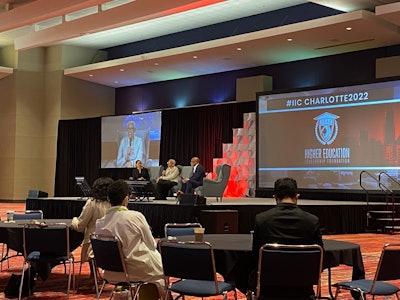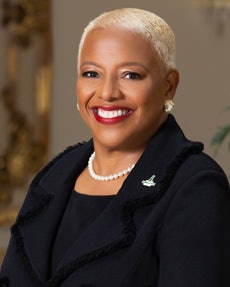 Presidents of Benedict College (Dr. Roslyn Clark Artis), Norfolk State University (Dr. Javaune Adams-Gaston), and Virginia State University (Dr. Makola Abdullah) discuss partnerships between HBCUs.
Presidents of Benedict College (Dr. Roslyn Clark Artis), Norfolk State University (Dr. Javaune Adams-Gaston), and Virginia State University (Dr. Makola Abdullah) discuss partnerships between HBCUs.
Just two days before, the Transformational Partnerships Fund, an initiative to support institutions of higher education explore partnerships with a commitment to diversity and equity, asked those in attendance to collaborate across institutions and propose a project focused on improving student outcomes. Applicants had roughly 24 hours to work together and submit.
The eight winners came together in two groups—Harris-Stowe State University, Wiley College, Arkansas Baptist College, Lemoyne-Owen College, and Southern University System in one group, and Wilberforce University, Delaware State University, and Tuskegee University in another. Both submitted proposals regarding mental health on their campuses. The grant money, $50,000, will be split between them.
Collaboration was a requirement for the competition and a key theme of the conference, hosted by the Higher Education Leadership Foundation, which brings together HBCU leaders and stakeholders to discuss a range of issues facing their schools. Consistently, each speaker underscored the notion that, by coming together, HBCUs can move the needle on their resources, research capacity, and serve even more students of color for decades to come.
“We are not competitors, we are collaborators, partners in this work, united together,” said Dr. Roslyn Clark Artis, president of Benedict College in Columbia, SC. “[HBCUs] are all a family—it’s about sisterhood and brotherhood and ultimately educating our young people. The special sauce, the secret of HBCUs—we’re organized for a purpose, mission driven.”
 Dr. Javaune Adams-Gaston, president of Norfolk State University.
Dr. Javaune Adams-Gaston, president of Norfolk State University.
“One of the exciting things that’s happened from COVID-19 is, we’ve realized there are things we can do without having intense proximity, we can branch off to other campuses,” said Abdullah. “Research collaboration for us as HBCUs is the key to building larger research enterprises. I believe it’s a place we have to go together. Together, we can punch way above our weight.”
Since their inception, HBCUs have been notoriously underfunded. Some of the clearest examples of this underfunding comes from the 19 land-grant HBCUs. By law, land-grant institutions are required to receive from the state dollar for dollar what their Predominately White Institution (PWI) counterparts receive. But, as the 2006 lawsuit brought against the state of Maryland reveals, state support has been far from equitable. Maryland settled in 2021 by signing legislation that will give $577 million to its four HBCUs, including one land-grant institution, the University of Maryland Eastern Shore.
Norfolk State University and Virginia State University "are public institutions, chasing the public dollars and competing against really big institutions who believe they should get everything,” said Adams-Gaston. “All of us who sit in these positions know that money matters. We have to have money to continue to have these institutions. That’s a hard reality because money isn’t easy to come by. But if we collaborate and work at this, what we’re doing is raising funds for our future, not just for today.”
Adams-Gaston said that working together on research is even more important to ensure Black voices are included in medical and mental health research. She and Abdullah ruminated on the theoretical impact that HBCU research could have had were it a key player in the COVID vaccine, and how Black communities may have been keener to trust the science had they been able to play a larger role in its development.
 Dr. Makola Abdullah, president of Virginia State University.
Dr. Makola Abdullah, president of Virginia State University.
Dr. Howard O. Gibson, vice president for academic affairs and strategic retention at Wiley College, expanded on how HBCUs can collaborate to fund research or build research centers. Gibson underlined partnerships within HBCUs, but also said that institutions should investigate local and national connections, even looking to pair with other Minority-Serving Institutions or even PWIs.
No matter the size of the HBCU, whether it’s two-year, four-year, public or private, Gibson urged those in attendance to truly get to know themselves, what they want to accomplish, and apply—no support will ever be received if faculty or administration do not submit applications in the first place.
“Sometimes we condition ourselves, we say, ‘Oh, we’re too small.’ But we’re mighty people,” said Gibson. “We’re already minimized. Don’t minimized yourself.”
Liann Herder can be reached at [email protected].
Editor's Note: Since the initial publishing of this article, the grant size was doubled from $25,000 to $50,000.






















